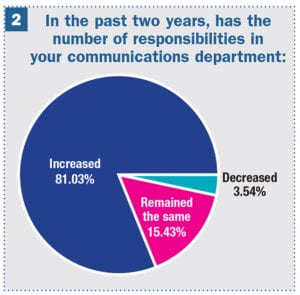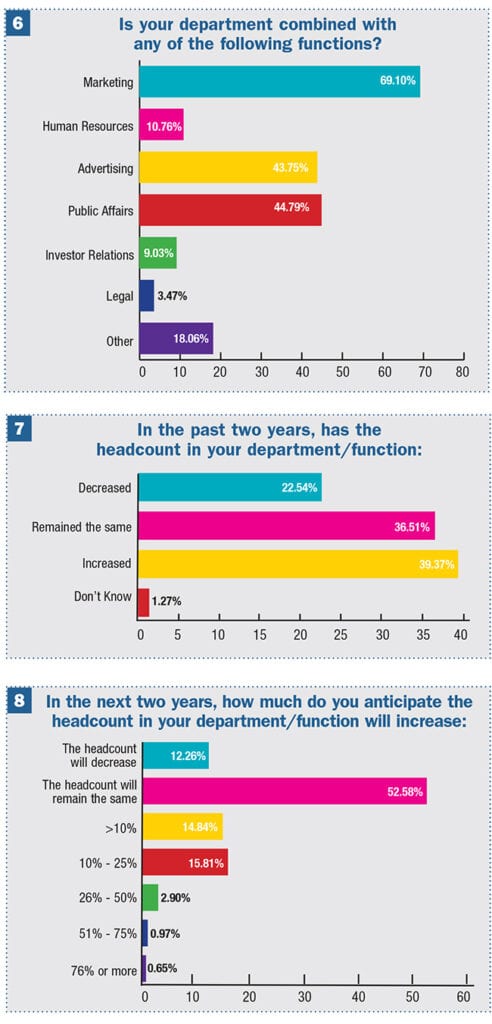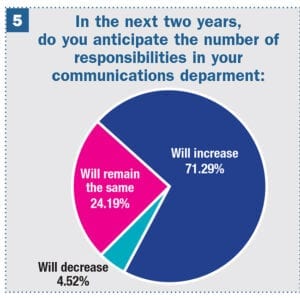
Begging Charles Dickens’s pardon, for PR it’s the best of times and the worst, according to a new survey about organization from PRNEWS and the Institute of PR (IPR). More than 300 respondents tell us communication is in demand across the company, yet budgets and headcounts are stuck.
First, the good news: communicators’ responsibilities are growing (see Charts 1 and 2). A rousing 81 percent say PR’s responsibilites have increased during the past two years (chart 2). In addition, the survey shows a significant majority of communicators (71 percent) believe this trend will continue, at least in the near term (see Chart 5).


Importantly, PR is working in areas that require strategic skills, says Debra Miller, communication director at Cone Health and a former PRSA president and CEO [more on this below].
Flat Budgets Ahead

President/CEO Institute for PR
The not-so-good news? A tune many communicators know well, ‘Do More with Less,’ will remain popular. Its spin-off, ‘Do A Lot More with Less,’ will top the charts. With an uncertain economy, few C-Suites are willing to increase budgets to grow communication teams despite a larger remit.
“Nearly three-quarters of respondents say their budget has stayed the same or decreased during the past two years and 64 percent anticipate their headcount will remain the same or decrease,” says Tina McCorkindale, IPR’s president and CEO (charts 3 and 8).


Moreover, only 42 percent say their department/function is large enough to handle current responsibilities.
Turnover, Burnout and Success
Above, we made light of PR pros needing to do more with fewer resources, but it’s not a joke. Asking communicators to work across the enterprise and keeping budgets flat can lead to “turnover and burnout,” McCorkindale says.
In addition, PR pros are anxious. The survey’s open-ended questions allowed PR pros to voice concerns. Many reflect concern about increased expectations and flat or decreased budgets, she says.
Ironically, this predicament is, in part, a product of PR’s recent success. As we’ve noted in previous editions, the collision of the dual pandemics– COVID-19 and the racial-social upheaval surrounding George Floyd’s murder May 25–elevated the importance of communication in the CEO’s mind.

Founder/CEO Peppercomm
“PR now is mission-critical,” says Steve Cody, Peppercomm’s founder and CEO. “The C-Suite respects [communicators] because they saw how important we’ve been [during the pandemics].”
Adds McCorkindale, “Overall, communication departments have never been more valued than they are today.”
In addition, communication’s importance has risen as “companies realized that they needed to take a closer look at what they say, internally and externally, what their values are, and how they continue to retain, engage and even recruit workers, especially as many are remote and deskless,” Miller notes.
Adds Cody, “CEOs really woke up to the fact that if they can’t keep their workforce engaged, healthy and productive, they don’t have a business.”

Director, Communications Cone Health
Miller also points out a deficiency in the survey. “There were no questions that addressed the composition [of teams] from a diversity perspective.” Without a diverse, multigenerational communication team, she says, companies will lack a valuable perspective and ability to communicate with diverse audiences.

Marketers Too
The survey’s results has a misery-loves-company aspect. 10fold asked CMOs from 150 public and private B2B companies across the US about budgets and responsibilities. It found 61 percent of marketing budgets reduced due to the pandemic. Despite the cuts, 60 percent of the CMOs say key metrics to measure marketing were not changed. Just 25 percent say KPIs were reduced; 10 percent actually report increased metrics.
Beyond the Basics
Moving beyond the survey’s basic takeaways, we’ll look at other implications.
Cody is struck that the long list of PR’s responsibilities in chart 1 cements research the Page Society did in 2016. That research highlights the CCO’s reach across the company, putting her in excellent position to know the company’s strengths and weaknesses, which is essential for strategic counseling and crisis mitigation. This shows Page is right and that “communicators are the social and moral compass of the organization,” he says.
Miller is pleased that many of the areas PR pros are involved in across the company require strategy (chart 1). This cements communication’s place as strategic, helping to shed PR’s reputation as a soft skill, she says.
Good News for Students, Trades
Cody adds that the survey’s findings are welcome news for college students studying communication. While he concedes the survey’s findings about flat head counts and the uncertain economy mean job hunting won’t be easy, the need for communicators with a wide range of skills, particularly in data analysis, bodes well for graduates, many of whom have these competencies, he says.
As for communicators already in the business, they will need to add to their skillset. That should be good news for industry groups and trades that offer training. “This survey shows we can’t remain stagnant; communicators have to pursue professional development. There’s too much we’re expected to do and know about,” Miller says.
The survey was fielded for four months in 2020, including two months before the pandemic hit, and two after.
IPR will publish a full version of the survey early next month that will include additional charts and analysis. PRNEWS subscribers will receive a copy.

